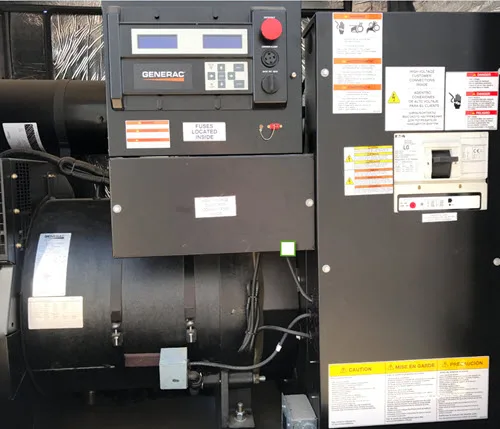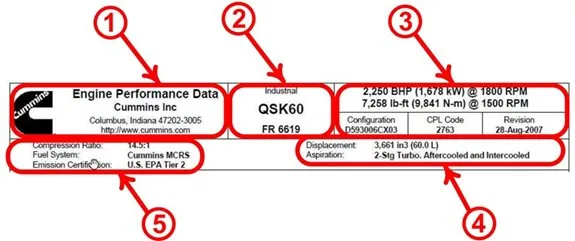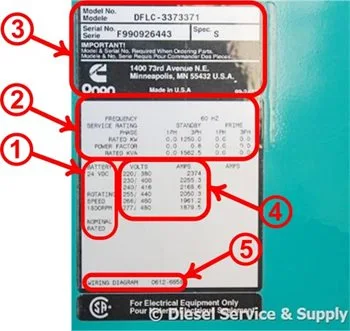Generator labels and data tags play a vital role in ensuring safe operation, effective maintenance, and accurate troubleshooting. These labels provide essential information about the generator’s engine and power generation systems, as well as safety precautions. This guide explores the types of labels commonly found on generator sets and the key details included in engine and generator data tags.
Types of Generator Labels
1. Data Tags
Data tags provide detailed specifications for the engine and generator, helping technicians troubleshoot and source replacement parts. These include:
- Engine Data Tags: Contain information specific to the engine, such as model, specifications, and configuration.
- Power Generation Tags: Include details about the generator’s output, wiring configurations, and operational parameters.

2. Caution Labels
- Appearance: Typically yellow.
- Purpose: Warn of practices that may damage the generator or its components.
- Examples:
- Automatic Start: Alerts users to automatic generator operation without prior warning.
- Maintenance Required: Indicates the next inspection or servicing requirements.
- Dual Supply: Identifies systems with multiple power sources.
3. Warning/Danger Labels
- Appearance: Generally red.
- Purpose: Highlight serious risks, such as high voltage or carbon monoxide exposure, that can result in injury, death, or equipment damage.
- Examples:
- High Voltage: Warns about access points with high electrical power.
- Arc Flash/Shock: Indicates arc flash hazards and safe distances.
- Carbon Monoxide: Alerts users to potential poisoning risks from improper exhaust management.
Engine Data Tags
Cummins Engine Tags (Figure 1)
Cummins engine tags are securely attached in visible locations on the engine. If the tag is missing or difficult to locate, contact Cummins Customer Assistance.
The data tag includes the following key sections:

- Manufacturer Identification
- Company headquarters and contact information.
- Engine Identifier
- Identifies the engine series (e.g., QSK60 Industrial Series).
- Engine Specifications
- Brake Horsepower (BHP): 2250 BHP (1678 kW) at 1800 RPM.
- Torque: 7258 lb-ft (measures twisting force).
- Configuration Number: Internal assembly details.
- Control Parts List (CPL): Reference for replacement parts.
- Revision: Software and electronics update information.
- Engine Displacement and Aspiration
- Displacement: 3.661 in³ (60 L) – the volume of all cylinders combined.
- Aspiration: Two-stage turbocharger system with intercooling and aftercooling.
- Fuel and Emissions
- Compression Ratio: 14.5:1 (ratio of maximum to minimum cylinder volume).
- Fuel System: Modular Common Rail System (MCRS) for high-pressure fuel delivery.
- Emission Certification: Complies with EPA Tier 2 standards.
Caterpillar Engine Tags (Figure 2)

Caterpillar engine tags are also attached in accessible areas. If the tag is missing, contact Caterpillar Maintenance and Support for assistance.
The data tag includes the following key sections:
- Model Number
- Identifies the engine type (e.g., CAT C175-20).
- Manufacturer Information
- Indicates Caterpillar as the manufacturer along with copyright details.
- Product Identification Number
- Used for service and parts ordering (e.g., CATC1752HBXR01224).
- Manufacturer Location
- Lists headquarters and production site information.
Power Generation Data Tags
Power Generation
When the generator manufacturer completes building and testing the generator, a data tag is attached to it. This tag provides critical information about the generator and basic details about the engine, enabling technicians to select the appropriate technical manuals for maintenance and troubleshooting. Below, we examine Cummins/Onan and Caterpillar generator data tags.
Cummins/Onan Generator Set Tags (Figure 3)
Cummins/Onan generator data tags, often referred to as electric motor nameplates, are securely attached to the generator in an easy-to-view location. These tags are essential for understanding operational parameters and troubleshooting issues. If the nameplate or tag is missing, contact Cummins Customer Assistance for replacement or guidance.
The generator data tag (Figure 3) is divided into the following sections:

1. Generator Operating Information
- Battery Requirement: A 24 VDC battery bank is required for the generator set application.
- Rotating Speed: The generator operates at 1800 RPM.
- Rating: Nominally rated for standby power applications.
2. Generator Specifications
- Frequency: Operates at 60 Hz.
- Operation Mode: Rated for standby operation only. (Some generators may include both standby and prime ratings.)
- Output: Three-phase operation at 1250 kW (1562.5 KVA) with a 0.8 power factor.
3. Manufacturer Information
- Includes details such as the manufacturer’s location, generator model, and serial numbers for identification.
4. Connection Information
- Voltage and Amperage: Information is provided in VOLTS and AMPS columns, detailing the amperage draw for various voltage configurations.
5. Wiring Diagram Number
- Reference for troubleshooting and wiring configuration options, assisting technicians with repairs and connection adjustments.
These tags are critical for ensuring safe operation, proper maintenance, and effective troubleshooting of Cummins/Onan generator sets. Always follow the information provided on these data tags to maintain the efficiency and longevity of your generator.
Caterpillar Generator Set Tags (Figure 4)
Caterpillar generator data tags are securely attached to the engine in a visible and accessible location. These tags provide crucial details about the generator’s specifications and operational parameters, helping technicians troubleshoot and maintain the equipment effectively. If the tag is missing, contact Caterpillar Maintenance and Support for assistance.
The generator data tag (Figure 4) is divided into the following sections:

1. Manufacturer and Description
- Identifies the unit as a Caterpillar Generator Set.
2. Generator Specifications
- Engine Model: 3508, manufactured in 2002.
- Output Power: 1250 KVA, 1000 kW with a 0.8 power factor at 60 Hz.
- Usage: Rated for standby use only.
3. Generator Data
- Wiring Configurations: 3-phase, 6-wire generator; can be wired in Delta (wye) or Parallel (series) configurations by technicians.
- Voltage and Amperage: Supplies 480 VAC with a 1504-amp capability.
- Excitation Requirements: Requires 43 VAC at 8 amps to excite the field.
- Rotating Speed: A minimum of 1800 RPM is required.
- Operating Temperatures: The maximum operating temperature is 266°F (130°C), with an ambient temperature limit of 104°F (40°C).
- Insulation Class: Equipped with Class H insulation in the windings.
- Altitude Capability: Designed for operation at elevations up to 3280 ft (1000 m).
4. Serial Number
- The generator serial number is provided to order parts and services.
These data tags ensure that technicians and operators have access to vital information for the safe and efficient use of Caterpillar generator sets. Following the details on the tag helps maintain performance and prolong the life of the generator. Always consult the tag or contact Caterpillar Maintenance and Support for specific queries or assistance.
Caution Labels (Figure 5)
Caution labels (Figure 5) are designed to warn users of practices that may cause damage to the generator set or associated equipment. These labels are often placed in conjunction with warning or danger labels to provide additional context, such as highlighting dual voltage supplies. Below are some examples of common caution labels and their purposes:
Automatic Start
- Purpose: Alerts individuals entering spaces or enclosures that the generator can start automatically without prior warning or consent.
- Placement: Typically placed at entrances to generator enclosures or rooms.

Maintenance Required
- Purpose: Tracks maintenance and inspection requirements.
- Usage: Updated after each maintenance task is completed to ensure proper scheduling of future inspections.
Emergency Generator
- Purpose: Identifies the location of emergency generators.
- Placement: Found on the outside of enclosures or doors to generator rooms.
Dual Supply
- Purpose: Provides information about dual voltage systems and their isolation points.
- Placement: Located near warning labels on electrical panels to supplement isolation instructions.
Caution labels are a critical part of generator safety and maintenance, helping to prevent equipment damage and ensuring proper operational practices. Always follow the instructions provided on these labels to ensure safe and efficient generator use.
Warning/Danger Labels (Figure 6)
Warning and Danger labels (Figure 6) are critical safety indicators used throughout generator systems. These industry-standard labels convey vital information about potential hazards, helping to prevent serious injuries, fatalities, and equipment damage. Adherence to these warnings is essential for safe operation and maintenance. Below are examples of common warning and danger labels found in generator applications:
2nd Power Source
- Purpose: Alerts users to dual power sources at panels, emphasizing the importance of securing both sources before maintenance.
- Placement: Found at panels with dual power supplies, often accompanied by a label indicating the locations to secure the power source.

Arc Flash/Shock
- Purpose: Warns of the risk of arc flashes or electric shocks at generator connection panels.
- Details: Indicates the voltage and safe distance required to avoid hazards.
- Placement: Displayed prominently on generator connection panels.
High Voltage
- Purpose: Highlights areas with high electrical power connections that pose a serious risk.
- Placement: Located at all access points in the power generation system where high voltage is present.
Carbon Monoxide
- Purpose: Warns of the dangers of carbon monoxide poisoning from generator exhaust.
- Placement: Found at exhaust points of installed generators and always on residential portable generators.
- Note: Improper ventilation of generator exhaust can be fatal.
Surface
- Purpose: Identifies surfaces designed for operator protection but not intended for standing or climbing.
- Placement: Found on protective structures or enclosures associated with the generator system.
Importance of Compliance
Ignoring the information on these labels can result in life-threatening injuries, significant equipment damage, and legal liabilities. Always follow the instructions provided on Warning and Danger labels and consult with qualified personnel for any uncertainties regarding generator operation or maintenance.
Generator labels and data tags are essential for safe operation, maintenance, and troubleshooting. They provide vital information about the engine, generator, and associated systems. By adhering to the instructions on caution and warning labels, users can ensure the longevity and safety of their generator set. If additional assistance is required, always consult the manufacturer or a qualified technician.